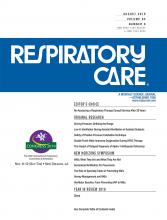Research ArticleOriginal Research
Attaining Low Tidal Volume Ventilation During Patient Triggered Ventilation in Sedated Subjects
Moe Koide, Akinori Uchiyama, Tomonori Yamashita, Takeshi Yoshida and Yuji Fujino
Respiratory Care August 2019, 64 (8) 890-898; DOI: https://doi.org/10.4187/respcare.06197
Moe Koide
Department of Anesthesiology and Intensive Care Medicine, Osaka University Graduate School of Medicine, Suita, Japan.
Akinori Uchiyama
Department of Anesthesiology and Intensive Care Medicine, Osaka University Graduate School of Medicine, Suita, Japan.
Tomonori Yamashita
Department of Anesthesiology and Intensive Care Medicine, Osaka University Graduate School of Medicine, Suita, Japan.
Takeshi Yoshida
Department of Anesthesiology and Intensive Care Medicine, Osaka University Graduate School of Medicine, Suita, Japan.
Yuji Fujino
Department of Anesthesiology and Intensive Care Medicine, Osaka University Graduate School of Medicine, Suita, Japan.
In this issue
Respiratory Care
Vol. 64, Issue 8
1 Aug 2019
Attaining Low Tidal Volume Ventilation During Patient Triggered Ventilation in Sedated Subjects
Moe Koide, Akinori Uchiyama, Tomonori Yamashita, Takeshi Yoshida, Yuji Fujino
Respiratory Care Aug 2019, 64 (8) 890-898; DOI: 10.4187/respcare.06197








